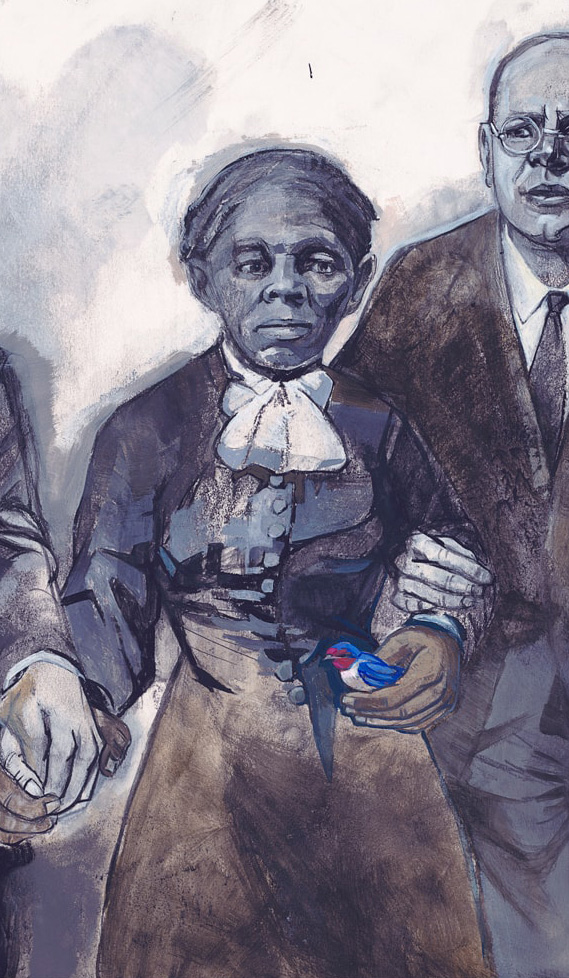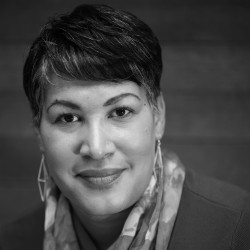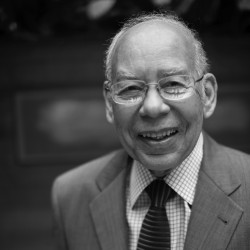+ We’ve been working on this issue for nearly two years, so the timing of its release in this season of upheaval is thought-provoking. Conversations have become more complex and people are skittish about engaging “race” and “reconciliation” in print at a time when the tectonic plates of American culture are shifting. The terrain around this conversation can be treacherous: we should not be daunted but rather humbled as we attempt to further the conversation on race at Fuller because, as Jeanelle Austin of the Pannell Center said the other day, “I’m tired of panels and conversations and just talking. It’s time to work.” Your lips to God’s ears, sister. —Editor
JOY J. MOORE: Christian Scripture sets forth an agenda premised on neighborly love. Followers of Christ, said Jesus, are to be recognized by how they love one another. In the first century, Jews and Gentiles together bearing witness to the lordship of Jesus Christ, demonstrated the presence and peace of God. Ultimately, the promise of the peaceful future of God will be realized when every nation worships together saying, “Jesus is Lord.” This is our ministry of reconciliation.
The church is the only institution whose chartering concept requires reconciliation across the most estranged of human chasms: captive and captor, male and female, our cultural group and theirs. Yet the most persistent transgression of a nation confident to claim itself founded on biblical principles is cultural fragmentation. Church gatherings perfectly display America’s flagrant scandal: division by the socially constructed categories of race. Nowhere is this more evident than the segregation of blacks and whites.
Tony Evans, in the introduction of his book Oneness Embraced, submits that the reason there remains a problem with race in America is because of the church’s failure to understand the issues from a biblical perspective.1 The lingering reality of racial division offers the quintessential exhibit of the effects of perpetuating a false idea. For Christians, it is evidence of allowing a cultural philosophy to be read into the biblical narrative. No human thought, with the exceptions of mathematics and parts of the natural sciences, is immune to the ideologizing influences of its social context, yet knowledge of the construction of the idea of race in modern Western thinking eludes contemporary imaginations. Unaware of how this false ideology originated, we regularly digest well-crafted lies in the guise of channeled entertainment, cultural enlightenment, and communicated education. It then becomes how we read the events recorded in the ancient text. Rather than being called into a different community by Scripture, we see our broken communities as justified by Scripture.
Unaware of the philosophical narratives that have shaped our theological imaginations, our conversations and actions collapse under the weight of headlines that reveal the depth of the racial chasm within the United States. Sanford. Ferguson. Staten Island. Baltimore. Charleston. As the suffering continues, Christians must ask, “If we say we love a wonder-working God whom we have not seen, is it possible to love our neighbors whom we do see?” This question becomes more poignant when we remember the alternative story Jesus told when asked by someone well-intentioned, “Who is my neighbor?” More than ask the question, we need an alternative narrative to talk ourselves out of the fictions we have been told. In this theology section of FULLER magazine, Reggie Williams notes that “concepts like post-racial and colorblindness are inadequate to mobilize people for healthy, genuine social interaction that is capable of moving us past the problems of racializing.” Is providing the world a glimpse of God’s multiethnic, multicultural community a mobilizing possibility?
We have inherited a world rife with war, dysfunctional families, creeping totalitarianism, diminished human rights, and a destructive system of incarceration. And yet it’s the church that epitomizes the brokenness of society on Sunday morning when we separate into worshipping communities that demonize those who don’t agree with us, disengage those that don’t act like us, and disregard those who don’t accommodate our systems of organization. The separation of church and state is a modern misnomer, suggesting that our beliefs about God do not impact our day-to-day practices. Again, Williams exposes that our understanding of God “can be the stimulus for creative resistance to oppression, or a sedative for benign acceptance of the dominant racialized depictions of people of color.” Rather than challenge the worldly status quo, religious groups perpetuate stereotypes, sectarianism, and schisms when accepting ethnic denominational identities—inverting Pentecost by reading in multiple languages unrecognizable by listeners and offering separate worship services according to musical preference.
I do believe there exists a genuine desire among many to move beyond the divisions that separate us. I have been encouraged by the students I teach as well as members of the congregations I have served that there are in this generation Christians who desire for the work of the Holy Spirit to convert us and the communities we inhabit. The difficult thing about biblical reconciliation is its requirement that we no longer regard one another from the perspective of human categories. That requires identifying the real enemy. Willie Jennings rightly names the need for reconciliation as a confrontation with “principalities” that requires moving beyond the fear that “normalizes oppression.”
Historically, the evangelical church has been one of the most closed communities for diversity, particularly for African Americans. This is why men like William E. Pannell and James Earl Massey have been so important—people who were on the forefront of social justice civil rights issues as evangelicals, African Americans who intentionally profess to be Christian, and, as Christians, who actively involve themselves in social justice as God requires. These men represent the blacks who migrated across North America in an effort to avoid the disparities of Jim Crow in the South, men and women who fought on the front lines with Martin Luther King Jr., but also those who walked with white evangelicals and dealt with that tension as Christians.
When I was in elementary school, one of the first heroes that captured my attention was a woman named Harriet Tubman. Her story exposed me to an understanding of black Christianity that has sustained me as some question the authenticity of being Christian when so many of the practices of racism have been authorized by the church quoting biblical texts. Tubman and other enslaved Africans demonstrated what it meant for the enslaved Africans to hear the slave masters’ religion and to summarily reject it. What they did next, as a displaced, marginalized, oppressed people, was accept the God to which the slave master’s Bible testified. In allowing the biblical story to become their story, the enslaved persons began to practice a better religion. It was that witness that enabled African Americans to practice Christianity. This understanding of Scripture and the work of the Holy Spirit in our lives today enables Koreans and Kenyans and Canadians and Kentuckians all to recognize God’s work of reconciliation among us.
“I had crossed the line of which I had so long been dreaming. I was free; but there was no one to welcome me to the land of freedom, I was a stranger in a strange land, and my home after all was down in the old cabin quarter, with the old folks, and my brothers and sisters. But to this solemn resolution I came; I was free, and they should be free also; I would make a home for them in the North, and the Lord helping me, I would bring them all there. Oh, how I prayed then, lying all alone on the cold, damp ground; ‘Oh, dear Lord,’ I said, ‘I ain’t got no friend but you. Come to my help, Lord, for I’m in trouble!’”
+attributed to Harriet Tubman, in Harriet, the Moses of Her People, by Sarah Hopkins Bradford. When Tubman (1822–1913) escaped slavery, she worked tirelessly as a “conductor” on the Underground Railroad to free others from slavery, compelled by her faith to help others still in bondage. She holds a swallow as a symbol of hope—something she clung to even as she addressed the systemic racism and sexism around her.
As Juan Martínez describes, we, too, must first “realize how deep the divisions” are that exist in our society. Like Martínez, we must never forget that “God had a different dream for his people,” because what the Holy Spirit does to bring reconciliation among the people called Christian, God intends to do with all the world.
Ultimately, our aim is to draw attention to the biblical narrative from which comes the strength for the long road of reconciliation. The biblical mandate is a reconciliation with God, with each other, and a reconciliation of the divided national ethnic groups of Genesis 11. We are living in a post-Genesis 3 reality that is God’s intended good creation turned inside out. At Genesis 12, the story takes a radical shift with a promise of reconciliation.
The biblical story tells of forming a community whose behavior is peculiar because it practices justice, favors mercy, and noticeably honors its God. Do not allow the familiar reference to Micah 6 to obscure the key idea: peculiar. Scripture is hauntingly relevant in its description of the idolatrous community that fails to be the peculiar people of God.
As in the ancient text, contemporary society experiences the tragedy of an internal collapse intensified by external assault. We’ve tried various programs, platforms, and promises, but too often our means of setting things right have not been submitted to the reign of God. Following the same instructions originally given to humanity, we, too, must innovate our way out of our current problematic situation and implement solutions that will work on a global scale. Ongoing clashes around the world remind us that ethnic and national divisions elsewhere are just as volatile as in the United States: the Ukraine, South Sudan, Central African Republic, Yemen, Libya, Mexico, Pakistan, Sudan, Somalia, Kenya, Palestine, Israel, and Korea come immediately to mind. Widen out from there to culture-war skirmishes from abortion to capital punishment, class divisions that span from Appalachian poverty to gated suburban communities, and gender issues that range from chauvinism and feminism to LGBTQ rights. One is tempted to believe that conflicts across professed affiliations, political alliances, and provincial attitudes will outlast our best attempts to reframe them, but we must try because, as Pannell says, “This is our work.” The Scriptures contain the wisdom to walk this out.
Maybe the work of reconciliation requires the church to be like the “Methodist, missionally minded, multiracial church in North Carolina” described by Love Sechrest. Having made the church a culturally homogenous gathering of folks just like ourselves, few congregations are reported to provide such an impressive “witness . . . to the power of the gospel” that it would be “too hard” to consider that place as a church home. Many growing congregations that attract our youth call for living in such hard places. Reconciliation begins when Christians live out the gospel with such grace-filled welcome that hatred is transformed into love, anger is transformed into forgiveness, and segregation is transformed into community. This is the New Testament vision. And it is no less a terrifying countercultural idea in the 21st century than it was when the apostle wrote: “If you belong to Christ, then you are . . . heirs to the promise” (Gal 3:29).
It is my prayer that every reader of this issue would consider the voices speaking here not as persons of color trying to correct Anglo-Americans, but as brothers and sisters in Christ humbly attempting to address the requirement to practice justice, favor kindness, and live so that God is glorified by testimonies against sin in our contemporary reality. As each person, in the voice that God has given him or her, witnesses to the transforming power of the risen Christ, we pray that the same Holy Spirit will enable each reader to recognize the sin that divides us and will empower all of us to join together in mutual service that glorifies God. Our collapsing world desperately needs this reconciled witness from the people of God called Christian.
ENDNOTE
1. Tony Evans, Oneness Embraced: Through the Eyes of Tony Evans (Chicago: Moody Press, 2011).
“For those of us who are not African Americans, our silence on issues of racial justice speaks volumes. Not only have we missed opportunities to stand with the victims of systemic violence, we have shielded our friends and families from the knowledge that black lives matter to us, not just in theory, but personally.”
+ Dan Stringer is a third-year MDiv student from Honolulu, Hawaii, pursuing an emphasis in Asian American Contexts. Read more from him and other members of the community here.
WILLIAM E. PANNELL: It is my contention that we are hung up on this whole reconciling race thing because we can’t get the relationship between conversion and ethics straight. Conversion never takes place in an ethical vacuum. We have an inadequate theology of evangelism on the one hand and impotence in the face of human suffering on the other. At stake is the integrity and future usefulness of the global church. Conversion is a profoundly ethical event. The details issuing from it will work themselves out differently in each person, but any conversion truth of the gospel should lead one to accept certain ethical values not supplied by any other source. These values are uniquely associated with the Holy Spirit, the Scriptures, and God’s kingdom purposes.
Reconciliation is the ministry of the church. What we need are models that the Good News works, not some trend that evangelism is passé. Reconciliation is a biblical word, it is our word, and its ministry is our enterprise. The Judeo-Christian tradition is essentially ethical in its demands, the expression of the requirements of a holy God that calls people to be like Jesus. Fellowship with fidelity to such a God requires obedience, holiness, and justice in human relationships. For this reason conversion is an ever-present demand.
The theme of reconciliation has become a dominant one in our time because of pain. There are underlying grievances. A race war has been brewing since the first boatload of slaves debarked on American shores and has been simmering since, with periodic eruptions such as those we’ve distressingly seen in the news of late. Animosity grows out of that unrelieved pain; reconciliation is the only way to peace. This challenge could result in the finest hour for the church. However, why would anyone take the church seriously when it speaks about reconciliation? We have no right to talk about this until we get our house in order. In a society characterized by alienation, our first responsibility is to love one another in the body of Christ. Love precedes reconciliation, as Paul argues in his Corinthian letter—it was the love of Christ that was the wellspring of all his actions. Yet we hardly know each other, let alone love one another! The impression I get from my colleagues in psychology, pastoral care, and counseling is that reconciliation is hard work! It requires confrontation and getting beyond mere words to true feelings and attitudes—many of which we may be unaware of. This presumes we have done the work of getting in the same room together.
How can one sustain a movement of justice and reconciliation apart from love and a commitment to “holiness”? The great social reform movements in American society were anchored in holiness movements—what happened to the church’s passion for it? Lesslie Newbigin spoke of the church as the “community of the Holy Spirit” in his book The Household of God, but we seem afraid of the Holy Spirit for fear we will become Pentecostals. Jon Sobrino argued for a “spirituality of liberation” in his book of that title, anchored in what he called “political holiness.” This, he argued, would be the way to a practical experience of God’s reign in our lives. Miroslav Volf was right in naming the issue of identity as the central motif of our times in Exclusion and Embrace. All sorts of tribalisms exist to further this quest, all of them fortified and justified in the names of God. The Christian God is love but also holy—both are keys to an enlightened discipleship in the service of community and justice.
Ethics get short-circuited in evangelism today because the enterprise is dictated not so much by careful biblical exegesis as by certain ideological assumptions within Western culture. Operating out of a hermeneutic of suspicion, many non-Westerners see the divorce of social ethics from evangelism as a product of a bourgeois evangelicalism out of touch with its history and its basic documents, with institutional expressions and prevailing assumptions that are largely racist. The racism I mean is the unconscious acceptance of the ideology of white supremacy, and the institutional racism based on that. In America, when that ideology is unconsciously accepted, the institutions of the majority culture will always be paternalistic in their relations with minority brothers and sisters. For this reason power and control become central ethical concerns that the church should be addressing. Instead, churches are valued in our culture, but not in any sense critical to modern life. Glen Stassen, Fuller colleague and coauthor of Just Peacemaking, would have agreed—waging peace is the church’s calling, and those whose political decisions make it difficult for citizens to live peaceably find their way to these churches only when war breaks out, as it has erupted so violently in recent months.
If the city has any hope, it lies with the church. It is not that the future of the city depends solely on the church, but rather that the glue that holds so much of the city together, certainly in black communities, is the church. Here the city’s potential leaders come for nourishment. Here its teachers, musicians, scholars, and families find inspiration and hope. The urban church is the hub of the community in ways foreign to its suburban counterpart. For this reason, the urban church carries a burden not required of its wealthier brothers and sisters elsewhere.
We have to start with recognition of the issue, confession that it exists, and a willingness to change. The fundamental problem is that white people who own the system as it is now do not allow the absence of black people to bother them. A black man might lead morning devotionals or be invited to deliver the keynote address, but he will not be invited to be present in the air-conditioned suite where policy is made and the future course is determined. It has not dawned on enough whites that the real issue is the integrity of the gospel itself and, consequently, the integrity of our witness to the rest of the world—where the majority is blessedly nonwhite.
“The fulfillment of the whole world is tied up with the dynamics and the deeds with everyone who lives in the world. When we come to understand that, we will not any longer separate anyone uncaringly to live apart and die in an unfriendly segregated ocean of isolation or suspicion or neglect—not when we value each other as persons.”
+ from James Earl Massey, distinguished preacher, professor, and dean emeritus at the Anderson University School of Theology, in a sermon at Dallas Theological Seminary. Massey has lectured at Fuller, written for FULLER magazine, and has preached around the world with vitality and an evangelical voice, represented here with a bundle of shamrocks, a three-leafed clover symbolic of the Holy Trinity.
Going forward means recognizing what many global brothers and sisters already know—that America is one of the toughest and neediest mission fields in the world. Change may mean fewer trips to Jerusalem for prophecy conferences and paying more attention to struggles for justice in Selma, Charleston, Sacramento, and Pasadena. We have the constant opportunity to be born again, to become everything we should and can be. Recent events have a way of revolutionizing attitudes and assumptions, of confronting us with realities we have been ignoring. That ought to awaken us.
The issues dividing believers today are deep-seated, going beyond merely reaching different theological conclusions: the divisions represent different hermeneutic starting points. Simply put, the Bible is understood one way in a poor neighborhood and quite another in the comfort of wealth. We have to start by acknowledging that we are approaching our shared Scriptures with different eyes: one’s point of view is determined largely by one’s point of viewing.
As black and white churches are distanced from one another along fault lines of ideology and praxis, the church will continue to live with the bifurcation between evangelism on the one hand and social responsibility on the other, between justice on the one hand and reconciliation on the other, between an ecclesiology defined along dispensational lines and an ecclesiology defined more in terms of the reign of God on earth. There are ways that Fuller can be very innovative in this. For example, we can develop curricular concentrations all the way up to the PhD level of how to think theologically in urban situations, and then train professionals and lay people both—in affordable ways—to do that.
Preachers spend an inordinate amount of time urging congregants to go into the world and communicate the good news. The truth is, the church is already in the world from nine to five every day and most of the night. An enormous Christian presence is already situated where the world hurts. The problem is, it does not always know what to do there. It is often ill-equipped intellectually to understand the world of ideas that affect the way people make choices. A trained laity could reinsert Christianity right back into the mainstream from which it has been marginalized. It’s interesting to note that a majority of our incoming students are coming for precisely this reason: to know how to engage their lives in the world with deeper theological roots. That privilege has to be made available to all. That’s justice in action.
Readers of the following pages will discover thoughts on that from some of our finest scholars here at Fuller. To broaden that thought a little bit: if we move from a discussion of reconciliation to spirituality, we move a short distance. New Testament writers regularly make the connection, as Paul did when writing to the fractious community at Corinth. The apostle John makes a similar case in his letters, albeit in different words. Check out Moses and the prophets and you will find they all say the same thing: professions to know God are empty if justice and mercy do not reign between people. In addition to defining our relationship with God, spirituality also defines the shortest distance between people. Reconciliation, at heart, is a spiritual issue.





